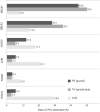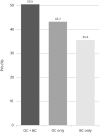Interdisciplinary risk counseling for hereditary breast and ovarian cancer: real-world data from a specialized center
- PMID: 36307613
- PMCID: PMC10110675
- DOI: 10.1007/s00404-022-06819-3
Interdisciplinary risk counseling for hereditary breast and ovarian cancer: real-world data from a specialized center
Abstract
Purpose: Hereditary breast and ovarian cancer has long been established to affect a considerable number of patients and their families. By identifying those at risk ideally before they have been diagnosed with breast and/or ovarian cancer, access to preventive measures, intensified screening and special therapeutic options can be obtained, and thus, prognosis can be altered beneficially. Therefore, a standardized screening and counseling process has been established in Germany under the aegis of the German Consortium for Hereditary Breast and Ovarian Cancer (GC-HBOC). As one of these specialized clinics, the HBOC-Center at Charité offers genetic counseling as well as genetic analysis based on the GC-HBOC standards. This analysis aims first at depicting this process from screening through counseling to genetic analysis as well as the patient collective and second at correlating the results of genetic analysis performed. Thus, real-world data from an HBOC-Center with a substantial patient collective and a high frequency of pathogenic variants in various genes shall be presented.
Methods: The data of 2531 people having been counseled at the HBOC-Center at Charité in 2016 and 2017 were analyzed in terms of patient and family history as well as pathogenic variants detected during genetic analysis with the TruRisk® gene panel when genetic analysis was conducted. This standardized analysis is compiled and regularly adjusted by the GC-HBOC. The following genes were included at time of research: BRCA1, BRCA2, ATM, CDH1, CHEK2, PALB2, RAD51C, RAD51D, NBN, and TP53.
Results: Genetic analysis was conducted in 59.8% of all cases meeting the criteria for genetic analysis and 286 pathogenic variants were detected among 278 (30.3%) counselees tested using the TruRisk® gene panel. These were primarily found in the genes BRCA1 (44.8%) and BRCA2 (28.3%) but also in CHEK2 (12.2%), ATM (5.6%) and PALB2 (3.5%). The highest prevalence of pathogenic variants was seen among the families with both ovarian and breast cancer (50.5%), followed by families with ovarian cancer only (43.2%) and families with breast cancer only (35.6%)-these differences are statistically significant (p < 0.001). Considering breast cancer subtypes, the highest rate of pathogenic variants was detected among patients with triple-negative breast cancer (40.7%) and among patients who had had been diagnosed with triple-negative breast cancer before the age of 40 (53.4%)-both observations proved to be statistically significant (p = 0.003 and p = 0.001).
Conclusion: Genetic counseling and analysis provide the foundation in the prevention and therapy of hereditary breast and ovarian cancer. The rate of pathogenic variants detected is associated with family history as well as breast cancer subtype and age at diagnosis, and can reach considerable dimensions. Therefore, a standardized process of identification, genetic counseling and genetic analysis deems mandatory.
Keywords: Digital tools; Genetic counseling; Hereditary breast cancer; Hereditary ovarian cancer.
© 2022. The Author(s).
Conflict of interest statement
The authors declare that they have no conflict of interest. The authors have no relevant financial or non-financial interests to disclose.
Figures





References
-
- World Health Organization . Regional office for Europe, world cancer report: cancer research for cancer development. Place of publication not identified: IARC; 2020.
Publication types
MeSH terms
Supplementary concepts
LinkOut - more resources
Full Text Sources
Medical
Research Materials
Miscellaneous

